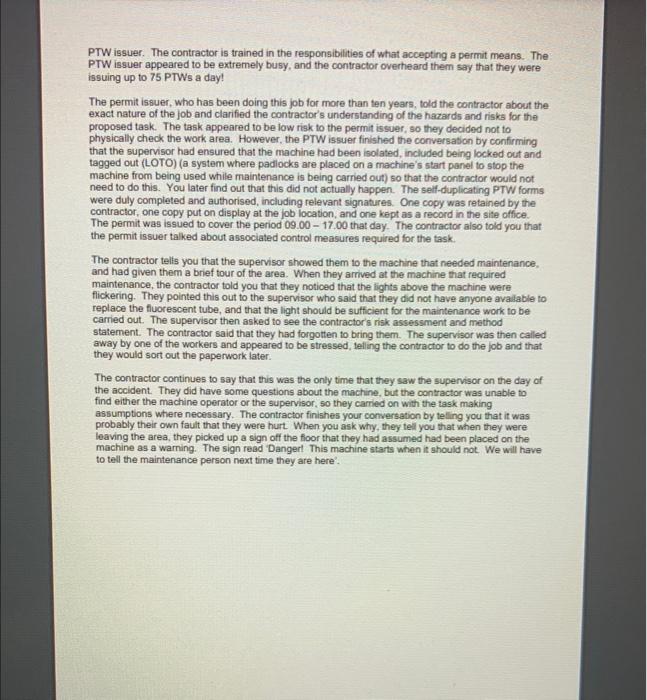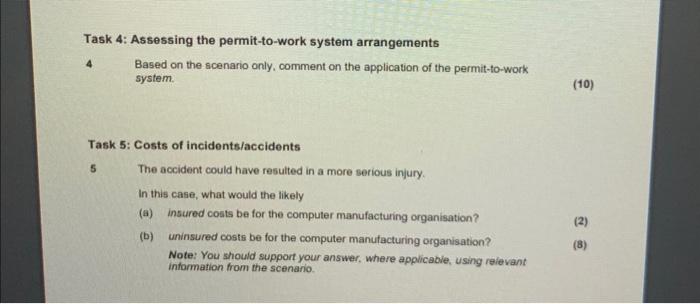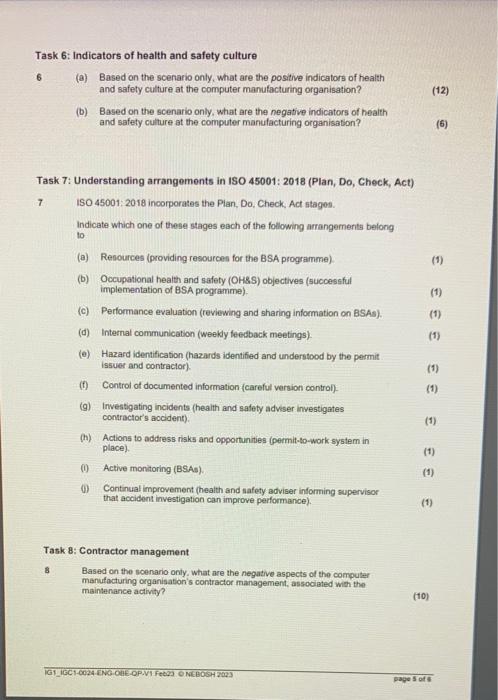I need an answer urgently
PTW issuer. The contractor is trained in the responsibilities of what accepting a permit means. The PTW issuer appeared to be extremely busy, and the contractor overheard them say that they were issuing up to 75 PTWs a day! The permit issuer, who has been doing this job for more than ten years, told the contractor about the exact nature of the job and clarifed the contractor's understanding of the hazards and risks for the proposed task. The task appeared to be low risk to the permit issuer, so they decided not to physically check the work area. However, the PTW issuer finished the conversasion by confirming that the supervisor had ensured that the machine had been isolated, included being locked out and tagged out (LOTO) (a system where padlocks are placed on a machine's start panel to stop the machine from being used while maintenance is being carried out) so that the contractor would not need to do this. You later find out that this did not actually happen. The self-duplicating PTW forms were duly completed and authorised, including relevant signatures. One copy was retained by the contractor, one copy put on display at the job location, and one kept as a record in the site office. The permit was issued to cover the period 09.0017.00 that day. The contractor also toid you that the permit issuer talked about associated control measures required for the task. The contractor telts you that the supervisor showed them to the machine that needed maintenance, and had given them a brief tour of the area. When they arrived at the machine that required maintenance, the contractor told you that they noticed that the lights above the machine were flickering. They pointed this out to the supervisor who said that they did not have anyone avalable to replace the fluorescent tube, and that the light should be sutficient for the maintenance work to be carried out. The supervisor then asked to see the contractor's risk assessment and method statement. The contractor said that they had forgotten to bring them. The supervisor was then called away by one of the workers and appeared to be stressed, lelling the contractor to do the job and that they would sort out the paperwork later. The contractor continues to say that this was the only time that they saw the supervisor on the day of the accident. They did have some questions about the machine, but the contractor was unable to find either the machine operator or the supervisor, so they carred on with the task making assumptions where necessary. The contractor finishes your conversation by telling you that it was probably their own fault that they were hurt. When you ask why, they tell you that when they were leaving the area, they picked up a sign off the floor that they had assumed had been placed on the machine as a warning. The sign read 'Dangert This machine starts when it should not. We will have to tell the maintenance person next time they are here'. Task 4: Assessing the permit-to-work system arrangements Based on the scenario only, comment on the application of the permit-to-work system. (10) Task 5: Costs of incidents/accidents 5 The accident could have resulted in a more serious injury. In this case, what would the likely (a) insured costs be for the computer manufacturing organisation? (2) (b) uninsured costs be for the computer manufacturing organisation? Note: You should support your answer, where applicable, using reievant information from the scenanio. Task 6: Indicators of health and safety culture 6 (a) Based on the scenario only, what are the positive indicators of health and safety culture at the computer manufacturing organisation? (12) (b) Based on the scenario only, what are the negative indicators of health and safety culture at the computer manufacturing organisation? (6) Task 7: Understanding arrangements in ISO 45001: 2018 (Plan, Do, Check, Act) 7. ISO 45001:2018 incorporates the Plan, Do, Check. Act stages. Indicate which one of these stages each of the following arrangements belong to. (a) Resources (providing resources for the BSA programme). (1) (b) Occupational health and safety (OHsS) objectives (successful implementation of BSA programme). (1) (c) Performance evaluation (reviewing and sharing information on BSAs). (1) (d) Internal communication (weekdy feedback meetings). (1) (e) Hazard identification (hazards identified and understood by the permit issuer and contractor). (1) (f) Control of documented information (careful varsion controi). (1) (g) Investigating incidents (health and safety adviser investigates contractor's accident). (1) (h) Actions to address risks and opportunities (permit-to-work system in place). (1) (1) Active monitoring (BSAs). (1) (0) Continual improvement (health and safety adviser informing supervisor that accident investigation can improve performance). (1) Task 8: Contractor management 8. Based on the scenario only, what are the negative aspects of the computar manufacturing organisation's contractor management, associated with the maintenance activity? (10) Task 9: Training recommendations 9 The computer manufacturing organisation wants to help ensure that a repeat of the contractor's accident becomes less likely, by helping to ensure that all workers and visitors to site receive appropriate training. Based on the scenario only, what training should the organisation arrange for the different types of workers










